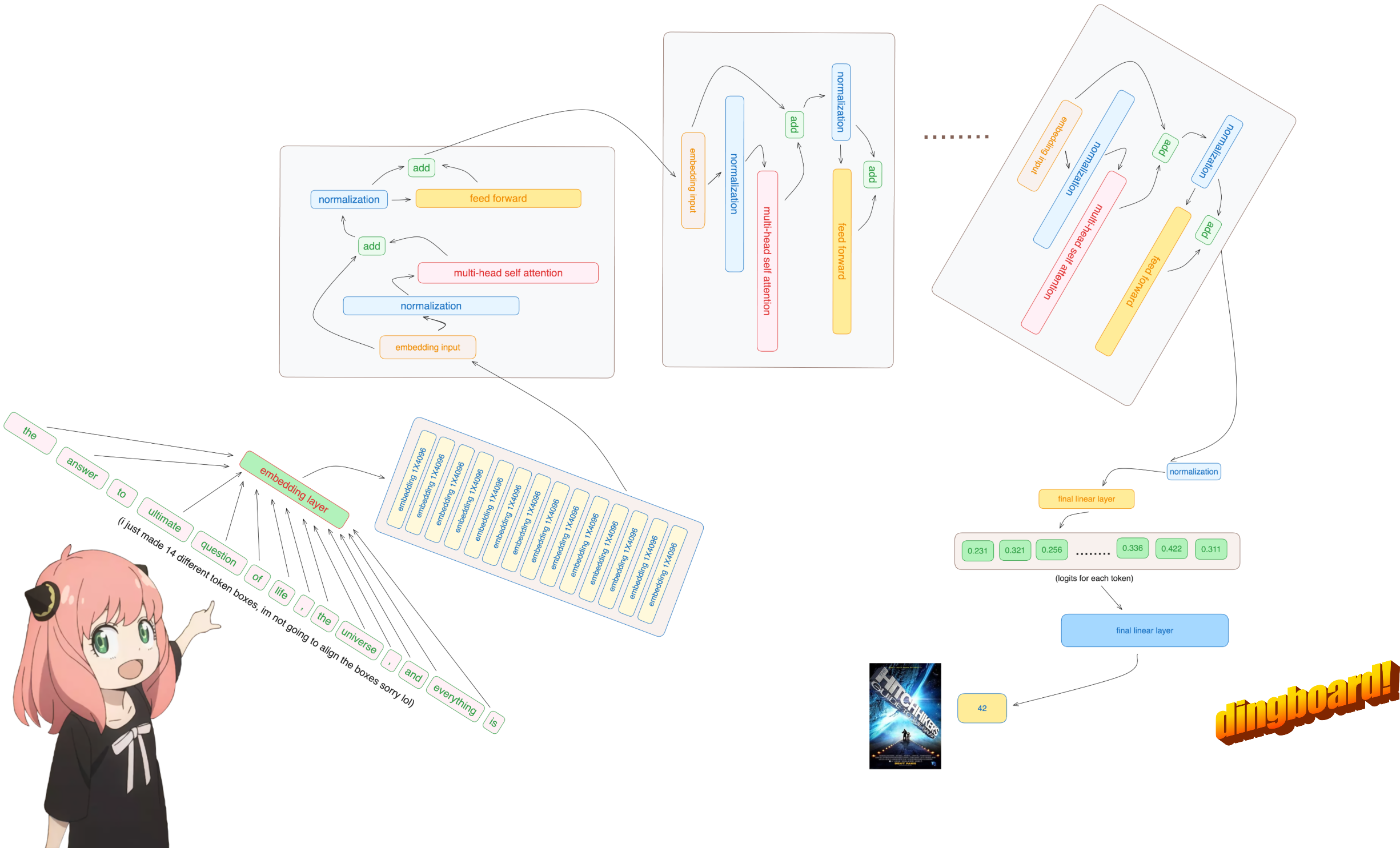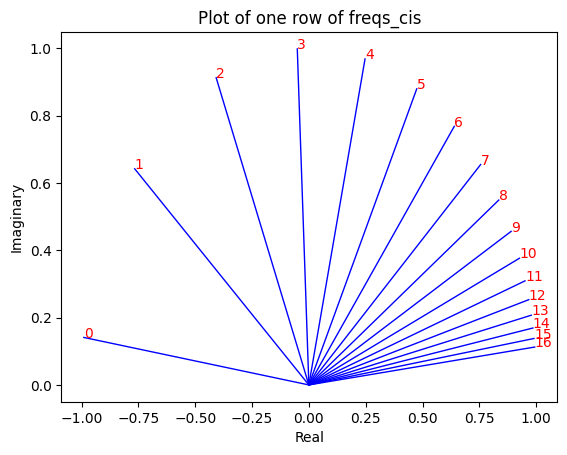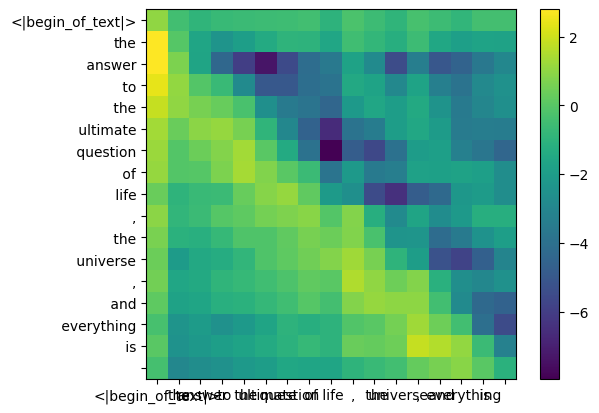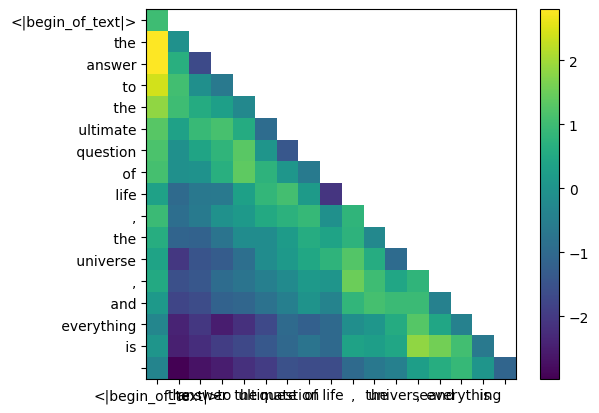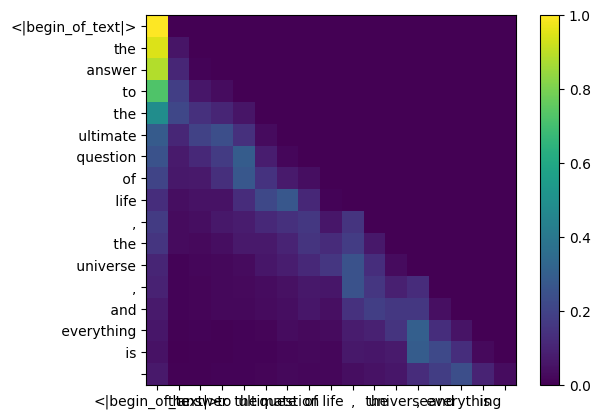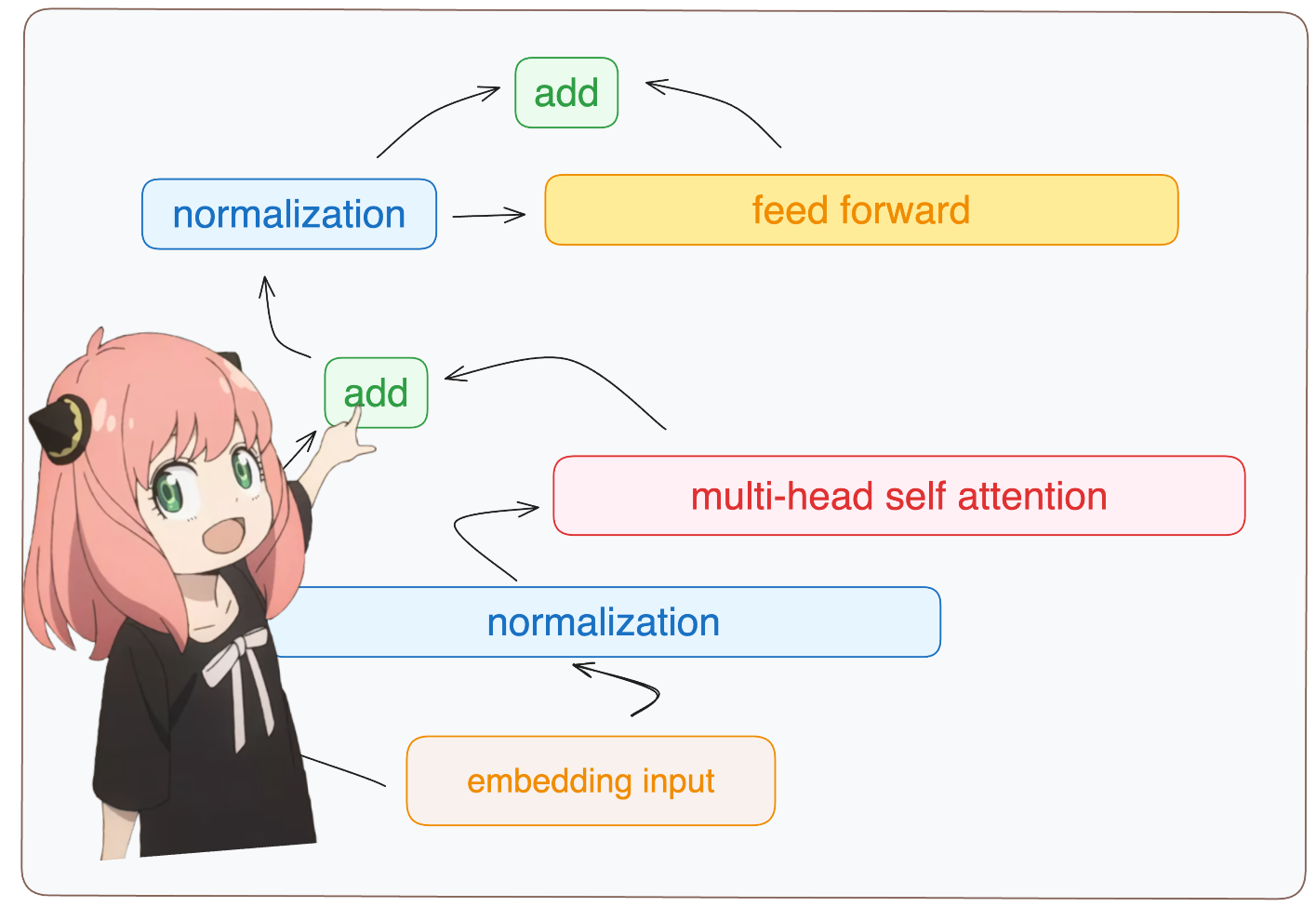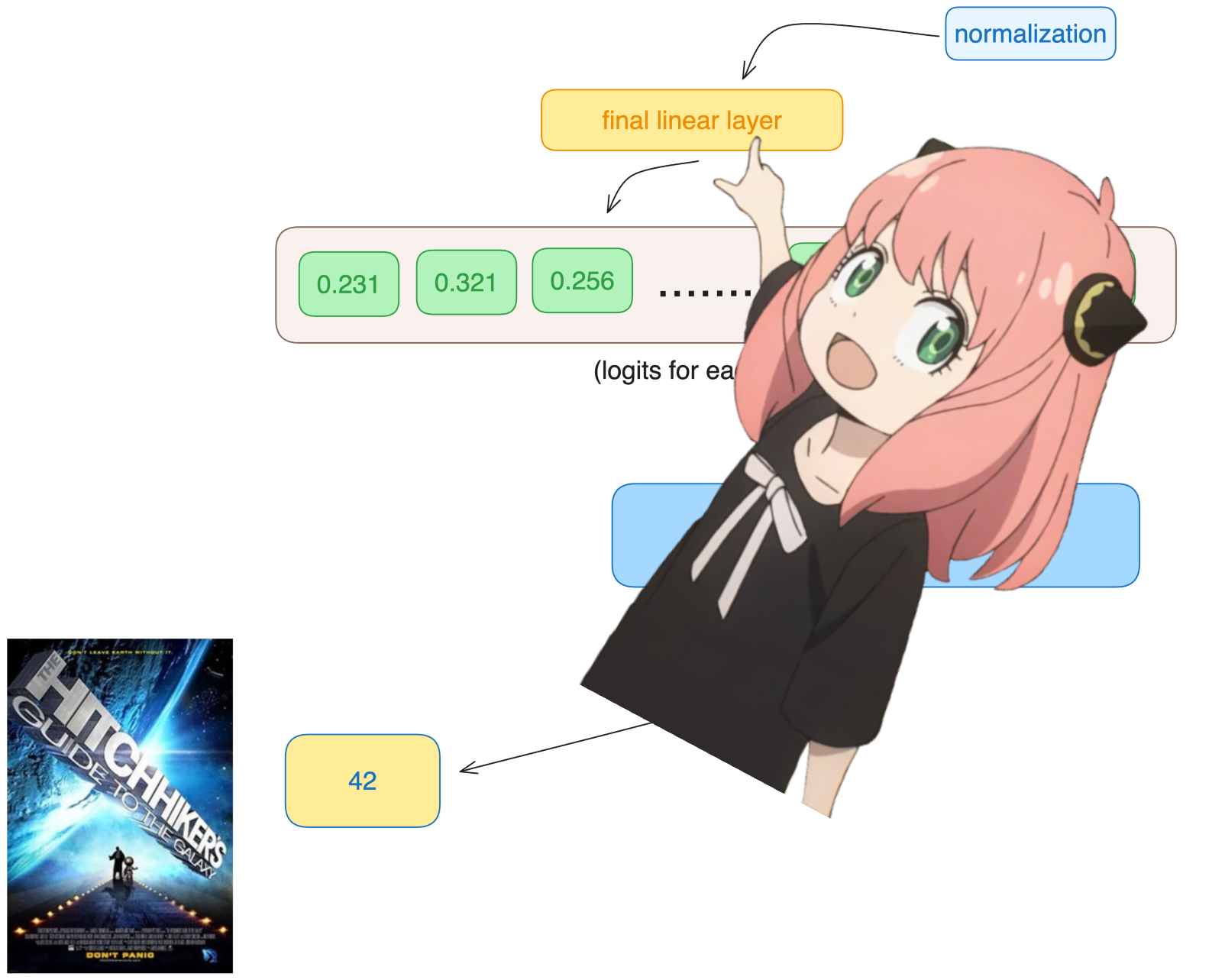in this file, i implemented llama3 from scratch, one tensor and matrix multiplication at a time.
also, im going to load tensors directly from the model file that meta provided for llama3, you need to download the weights before running this file.
here is the offical link to download the weights: https://llama.meta.com/llama-downloads/
im not going to implement a bpe tokenizer (but andrej karpathy has a really clean implementation)
link to his implementation: https://github.com/karpathy/minbpe
from pathlib import Path
import tiktoken
from tiktoken.load import load_tiktoken_bpe
import torch
import json
import matplotlib.pyplot as plt
tokenizer_path = "Meta-Llama-3-8B/tokenizer.model"
special_tokens = [
"<|begin_of_text|>",
"<|end_of_text|>",
"<|reserved_special_token_0|>",
"<|reserved_special_token_1|>",
"<|reserved_special_token_2|>",
"<|reserved_special_token_3|>",
"<|start_header_id|>",
"<|end_header_id|>",
"<|reserved_special_token_4|>",
"<|eot_id|>", # end of turn
] + [f"<|reserved_special_token_{i}|>" for i in range(5, 256 - 5)]
mergeable_ranks = load_tiktoken_bpe(tokenizer_path)
tokenizer = tiktoken.Encoding(
name=Path(tokenizer_path).name,
pat_str=r"(?i:'s|'t|'re|'ve|'m|'ll|'d)|[^\r\n\p{L}\p{N}]?\p{L}+|\p{N}{1,3}| ?[^\s\p{L}\p{N}]+[\r\n]*|\s*[\r\n]+|\s+(?!\S)|\s+",
mergeable_ranks=mergeable_ranks,
special_tokens={token: len(mergeable_ranks) + i for i, token in enumerate(special_tokens)},
)
tokenizer.decode(tokenizer.encode("hello world!"))'hello world!'
normally, reading this depends on how the model classes are written and the variable names inside them.
but since we are implementing llama3 from scratch we will read the file one tensor at a time.
model = torch.load("Meta-Llama-3-8B/consolidated.00.pth")
print(json.dumps(list(model.keys())[:20], indent=4))[
"tok_embeddings.weight",
"layers.0.attention.wq.weight",
"layers.0.attention.wk.weight",
"layers.0.attention.wv.weight",
"layers.0.attention.wo.weight",
"layers.0.feed_forward.w1.weight",
"layers.0.feed_forward.w3.weight",
"layers.0.feed_forward.w2.weight",
"layers.0.attention_norm.weight",
"layers.0.ffn_norm.weight",
"layers.1.attention.wq.weight",
"layers.1.attention.wk.weight",
"layers.1.attention.wv.weight",
"layers.1.attention.wo.weight",
"layers.1.feed_forward.w1.weight",
"layers.1.feed_forward.w3.weight",
"layers.1.feed_forward.w2.weight",
"layers.1.attention_norm.weight",
"layers.1.ffn_norm.weight",
"layers.2.attention.wq.weight"
]
with open("Meta-Llama-3-8B/params.json", "r") as f:
config = json.load(f)
config{'dim': 4096,
'n_layers': 32,
'n_heads': 32,
'n_kv_heads': 8,
'vocab_size': 128256,
'multiple_of': 1024,
'ffn_dim_multiplier': 1.3,
'norm_eps': 1e-05,
'rope_theta': 500000.0}
- the model has 32 transformer layers
- each multi-head attention block has 32 heads
- the vocab size and so on
dim = config["dim"]
n_layers = config["n_layers"]
n_heads = config["n_heads"]
n_kv_heads = config["n_kv_heads"]
vocab_size = config["vocab_size"]
multiple_of = config["multiple_of"]
ffn_dim_multiplier = config["ffn_dim_multiplier"]
norm_eps = config["norm_eps"]
rope_theta = torch.tensor(config["rope_theta"])here we use tiktoken (i think an openai library) as the tokenizer
prompt = "the answer to the ultimate question of life, the universe, and everything is "
tokens = [128000] + tokenizer.encode(prompt)
print(tokens)
tokens = torch.tensor(tokens)
prompt_split_as_tokens = [tokenizer.decode([token.item()]) for token in tokens]
print(prompt_split_as_tokens)[128000, 1820, 4320, 311, 279, 17139, 3488, 315, 2324, 11, 279, 15861, 11, 323, 4395, 374, 220]
['<|begin_of_text|>', 'the', ' answer', ' to', ' the', ' ultimate', ' question', ' of', ' life', ',', ' the', ' universe', ',', ' and', ' everything', ' is', ' ']
IM SORRY but this is the only part of the codebase where i use an inbuilt neural network module
anyway, so our [17x1] tokens are now [17x4096], i.e. 17 embeddings (one for each token) of length 4096
note: keep track of the shapes, it makes it much easier to understand everything
embedding_layer = torch.nn.Embedding(vocab_size, dim)
embedding_layer.weight.data.copy_(model["tok_embeddings.weight"])
token_embeddings_unnormalized = embedding_layer(tokens).to(torch.bfloat16)
token_embeddings_unnormalized.shapetorch.Size([17, 4096])
please, note after this step the shapes dont change, the values are just normalized
things to keep in mind, we need a norm_eps (from config) because we dont want to accidently set rms to 0 and divide by 0
here is the formula:
# def rms_norm(tensor, norm_weights):
# rms = (tensor.pow(2).mean(-1, keepdim=True) + norm_eps)**0.5
# return tensor * (norm_weights / rms)
def rms_norm(tensor, norm_weights):
return (tensor * torch.rsqrt(tensor.pow(2).mean(-1, keepdim=True) + norm_eps)) * norm_weightsyou will see me accessing layer.0 from the model dict (this is the first layer)
anyway, so after normalizing our shapes are still [17x4096] same as embedding but normalized
token_embeddings = rms_norm(token_embeddings_unnormalized, model["layers.0.attention_norm.weight"])
token_embeddings.shapetorch.Size([17, 4096])
let's load the attention heads of the first layer of the transformer
> when we load the query, key, value and output vectors from the model we notice the shapes to be [4096x4096], [1024x4096], [1024x4096], [4096x4096]
> at first glance this is weird because ideally we want each q,k,v and o for each head individually
> the authors of the code bundled them togeather because its easy it helps parallize attention head multiplication.
> im going to unwrap everything...
print(
model["layers.0.attention.wq.weight"].shape,
model["layers.0.attention.wk.weight"].shape,
model["layers.0.attention.wv.weight"].shape,
model["layers.0.attention.wo.weight"].shape
)torch.Size([4096, 4096]) torch.Size([1024, 4096]) torch.Size([1024, 4096]) torch.Size([4096, 4096])
in the next section we will unwrap the queries from multiple attention heads, the resulting shape is [32x128x4096]
here, 32 is the number of attention heads in llama3, 128 is the size of the query vector and 4096 is the size of the token embedding
q_layer0 = model["layers.0.attention.wq.weight"]
head_dim = q_layer0.shape[0] // n_heads
q_layer0 = q_layer0.view(n_heads, head_dim, dim)
q_layer0.shapetorch.Size([32, 128, 4096])
here i access the query weight matrix first head of the first layer, the size of this query weight matrix is [128x4096]
q_layer0_head0 = q_layer0[0]
q_layer0_head0.shapetorch.Size([128, 4096])
here you can see the resulting shape is [17x128], this is because we have 17 tokens and for each token there is a 128 length query.
q_per_token = torch.matmul(token_embeddings, q_layer0_head0.T)
q_per_token.shapetorch.Size([17, 128])
we are now at a stage where we have a query vector for each token in our prompt, but if you think about it -- the indivitually query vector has no idea about the position in the prompt.
query: "the answer to the ultimate question of life, the universe, and everything is "
in our prompt we have used "the" three times, we need the query vectors of all 3 "the" tokens to have different query vectors (each of size [1x128]) based on their positions in the query. we perform these rotations using RoPE (rotory positional embedding).
watch this video (this is what i watched) to understand the math. https://www.youtube.com/watch?v=o29P0Kpobz0&t=530s
q_per_token_split_into_pairs = q_per_token.float().view(q_per_token.shape[0], -1, 2)
q_per_token_split_into_pairs.shapetorch.Size([17, 64, 2])
in the above step, we split the query vectors into pairs, we apply a rotational angle shift to each pair!
we now have a vector of size [17x64x2], this is the 128 length queries split into 64 pairs for each token in the prompt! each of those 64 pairs will be rotated by m*(theta) where m is the position of the token for which we are rotating the query!
zero_to_one_split_into_64_parts = torch.tensor(range(64))/64
zero_to_one_split_into_64_partstensor([0.0000, 0.0156, 0.0312, 0.0469, 0.0625, 0.0781, 0.0938, 0.1094, 0.1250,
0.1406, 0.1562, 0.1719, 0.1875, 0.2031, 0.2188, 0.2344, 0.2500, 0.2656,
0.2812, 0.2969, 0.3125, 0.3281, 0.3438, 0.3594, 0.3750, 0.3906, 0.4062,
0.4219, 0.4375, 0.4531, 0.4688, 0.4844, 0.5000, 0.5156, 0.5312, 0.5469,
0.5625, 0.5781, 0.5938, 0.6094, 0.6250, 0.6406, 0.6562, 0.6719, 0.6875,
0.7031, 0.7188, 0.7344, 0.7500, 0.7656, 0.7812, 0.7969, 0.8125, 0.8281,
0.8438, 0.8594, 0.8750, 0.8906, 0.9062, 0.9219, 0.9375, 0.9531, 0.9688,
0.9844])
freqs = 1.0 / (rope_theta ** zero_to_one_split_into_64_parts)
freqstensor([1.0000e+00, 8.1462e-01, 6.6360e-01, 5.4058e-01, 4.4037e-01, 3.5873e-01,
2.9223e-01, 2.3805e-01, 1.9392e-01, 1.5797e-01, 1.2869e-01, 1.0483e-01,
8.5397e-02, 6.9566e-02, 5.6670e-02, 4.6164e-02, 3.7606e-02, 3.0635e-02,
2.4955e-02, 2.0329e-02, 1.6560e-02, 1.3490e-02, 1.0990e-02, 8.9523e-03,
7.2927e-03, 5.9407e-03, 4.8394e-03, 3.9423e-03, 3.2114e-03, 2.6161e-03,
2.1311e-03, 1.7360e-03, 1.4142e-03, 1.1520e-03, 9.3847e-04, 7.6450e-04,
6.2277e-04, 5.0732e-04, 4.1327e-04, 3.3666e-04, 2.7425e-04, 2.2341e-04,
1.8199e-04, 1.4825e-04, 1.2077e-04, 9.8381e-05, 8.0143e-05, 6.5286e-05,
5.3183e-05, 4.3324e-05, 3.5292e-05, 2.8750e-05, 2.3420e-05, 1.9078e-05,
1.5542e-05, 1.2660e-05, 1.0313e-05, 8.4015e-06, 6.8440e-06, 5.5752e-06,
4.5417e-06, 3.6997e-06, 3.0139e-06, 2.4551e-06])
freqs_for_each_token = torch.outer(torch.arange(17), freqs)
freqs_cis = torch.polar(torch.ones_like(freqs_for_each_token), freqs_for_each_token)
freqs_cis.shape
# viewing tjhe third row of freqs_cis
value = freqs_cis[3]
plt.figure()
for i, element in enumerate(value[:17]):
plt.plot([0, element.real], [0, element.imag], color='blue', linewidth=1, label=f"Index: {i}")
plt.annotate(f"{i}", xy=(element.real, element.imag), color='red')
plt.xlabel('Real')
plt.ylabel('Imaginary')
plt.title('Plot of one row of freqs_cis')
plt.show()we can convert our queries (the one we split into pairs) as complex numbers and then dot product to rotate the query based on the position
honeslty this is beautiful to think about :)
q_per_token_as_complex_numbers = torch.view_as_complex(q_per_token_split_into_pairs)
q_per_token_as_complex_numbers.shapetorch.Size([17, 64])
q_per_token_as_complex_numbers_rotated = q_per_token_as_complex_numbers * freqs_cis
q_per_token_as_complex_numbers_rotated.shapetorch.Size([17, 64])
we can get back our the queries as pairs by viewing the complex numbers as real numbers again
q_per_token_split_into_pairs_rotated = torch.view_as_real(q_per_token_as_complex_numbers_rotated)
q_per_token_split_into_pairs_rotated.shapetorch.Size([17, 64, 2])
the rotated pairs are now merged, we now have a new query vector (rotated query vector) that is of the shape [17x128] where 17 is the number of tokens and the 128 is the dim of the query vector
q_per_token_rotated = q_per_token_split_into_pairs_rotated.view(q_per_token.shape)
q_per_token_rotated.shapetorch.Size([17, 128])
> keys generate key vectors also of dimention 128
> keys have only 1/4th the number of the weights as queries, this is because the weights for keys are shared across 4 heads at a time, to reduce the number of computations need
> keys are also rotated to add positional info, just like queries because of the same reasons
k_layer0 = model["layers.0.attention.wk.weight"]
k_layer0 = k_layer0.view(n_kv_heads, k_layer0.shape[0] // n_kv_heads, dim)
k_layer0.shapetorch.Size([8, 128, 4096])
k_layer0_head0 = k_layer0[0]
k_layer0_head0.shapetorch.Size([128, 4096])
k_per_token = torch.matmul(token_embeddings, k_layer0_head0.T)
k_per_token.shapetorch.Size([17, 128])
k_per_token_split_into_pairs = k_per_token.float().view(k_per_token.shape[0], -1, 2)
k_per_token_split_into_pairs.shapetorch.Size([17, 64, 2])
k_per_token_as_complex_numbers = torch.view_as_complex(k_per_token_split_into_pairs)
k_per_token_as_complex_numbers.shapetorch.Size([17, 64])
k_per_token_split_into_pairs_rotated = torch.view_as_real(k_per_token_as_complex_numbers * freqs_cis)
k_per_token_split_into_pairs_rotated.shapetorch.Size([17, 64, 2])
k_per_token_rotated = k_per_token_split_into_pairs_rotated.view(k_per_token.shape)
k_per_token_rotated.shapetorch.Size([17, 128])
doing this will give us a score mapping each token with one another
this score describes how well each token's query relates to the each tokens's key.
THIS IS SELF ATTENTION :)
the shape of the attention score matrix (qk_per_token) is [17x17] where 17 is the number of tokens in the prompt
qk_per_token = torch.matmul(q_per_token_rotated, k_per_token_rotated.T)/(head_dim)**0.5
qk_per_token.shapetorch.Size([17, 17])
during the training process of llama3, the future token qk scores are masked.
why? because during training we only learn to predict tokens using past tokens.
as a result, during inference we set the future tokens to zero.
def display_qk_heatmap(qk_per_token):
_, ax = plt.subplots()
im = ax.imshow(qk_per_token.to(float).detach(), cmap='viridis')
ax.set_xticks(range(len(prompt_split_as_tokens)))
ax.set_yticks(range(len(prompt_split_as_tokens)))
ax.set_xticklabels(prompt_split_as_tokens)
ax.set_yticklabels(prompt_split_as_tokens)
ax.figure.colorbar(im, ax=ax)
display_qk_heatmap(qk_per_token)mask = torch.full((len(tokens), len(tokens)), float("-inf"), device=tokens.device)
mask = torch.triu(mask, diagonal=1)
masktensor([[0., -inf, -inf, -inf, -inf, -inf, -inf, -inf, -inf, -inf, -inf, -inf, -inf, -inf, -inf, -inf, -inf],
[0., 0., -inf, -inf, -inf, -inf, -inf, -inf, -inf, -inf, -inf, -inf, -inf, -inf, -inf, -inf, -inf],
[0., 0., 0., -inf, -inf, -inf, -inf, -inf, -inf, -inf, -inf, -inf, -inf, -inf, -inf, -inf, -inf],
[0., 0., 0., 0., -inf, -inf, -inf, -inf, -inf, -inf, -inf, -inf, -inf, -inf, -inf, -inf, -inf],
[0., 0., 0., 0., 0., -inf, -inf, -inf, -inf, -inf, -inf, -inf, -inf, -inf, -inf, -inf, -inf],
[0., 0., 0., 0., 0., 0., -inf, -inf, -inf, -inf, -inf, -inf, -inf, -inf, -inf, -inf, -inf],
[0., 0., 0., 0., 0., 0., 0., -inf, -inf, -inf, -inf, -inf, -inf, -inf, -inf, -inf, -inf],
[0., 0., 0., 0., 0., 0., 0., 0., -inf, -inf, -inf, -inf, -inf, -inf, -inf, -inf, -inf],
[0., 0., 0., 0., 0., 0., 0., 0., 0., -inf, -inf, -inf, -inf, -inf, -inf, -inf, -inf],
[0., 0., 0., 0., 0., 0., 0., 0., 0., 0., -inf, -inf, -inf, -inf, -inf, -inf, -inf],
[0., 0., 0., 0., 0., 0., 0., 0., 0., 0., 0., -inf, -inf, -inf, -inf, -inf, -inf],
[0., 0., 0., 0., 0., 0., 0., 0., 0., 0., 0., 0., -inf, -inf, -inf, -inf, -inf],
[0., 0., 0., 0., 0., 0., 0., 0., 0., 0., 0., 0., 0., -inf, -inf, -inf, -inf],
[0., 0., 0., 0., 0., 0., 0., 0., 0., 0., 0., 0., 0., 0., -inf, -inf, -inf],
[0., 0., 0., 0., 0., 0., 0., 0., 0., 0., 0., 0., 0., 0., 0., -inf, -inf],
[0., 0., 0., 0., 0., 0., 0., 0., 0., 0., 0., 0., 0., 0., 0., 0., -inf],
[0., 0., 0., 0., 0., 0., 0., 0., 0., 0., 0., 0., 0., 0., 0., 0., 0.]])
qk_per_token_after_masking = qk_per_token + mask
display_qk_heatmap(qk_per_token_after_masking)qk_per_token_after_masking_after_softmax = torch.nn.functional.softmax(qk_per_token_after_masking, dim=1).to(torch.bfloat16)
display_qk_heatmap(qk_per_token_after_masking_after_softmax)> just like keys, value weights are also shared acorss every 4 attention heads (to save computation)
> as a result, the shape of the value weight matrix below is [8x128x4096]
v_layer0 = model["layers.0.attention.wv.weight"]
v_layer0 = v_layer0.view(n_kv_heads, v_layer0.shape[0] // n_kv_heads, dim)
v_layer0.shapetorch.Size([8, 128, 4096])
the first layer, first head value weight matrix is given below
v_layer0_head0 = v_layer0[0]
v_layer0_head0.shapetorch.Size([128, 4096])
v_per_token = torch.matmul(token_embeddings, v_layer0_head0.T)
v_per_token.shapetorch.Size([17, 128])
qkv_attention = torch.matmul(qk_per_token_after_masking_after_softmax, v_per_token)
qkv_attention.shapetorch.Size([17, 128])
now im going to run a loop and perform the exact same math as the cells above but for every head in the first layer
qkv_attention_store = []
for head in range(n_heads):
q_layer0_head = q_layer0[head]
k_layer0_head = k_layer0[head//4] # key weights are shared across 4 heads
v_layer0_head = v_layer0[head//4] # value weights are shared across 4 heads
q_per_token = torch.matmul(token_embeddings, q_layer0_head.T)
k_per_token = torch.matmul(token_embeddings, k_layer0_head.T)
v_per_token = torch.matmul(token_embeddings, v_layer0_head.T)
q_per_token_split_into_pairs = q_per_token.float().view(q_per_token.shape[0], -1, 2)
q_per_token_as_complex_numbers = torch.view_as_complex(q_per_token_split_into_pairs)
q_per_token_split_into_pairs_rotated = torch.view_as_real(q_per_token_as_complex_numbers * freqs_cis[:len(tokens)])
q_per_token_rotated = q_per_token_split_into_pairs_rotated.view(q_per_token.shape)
k_per_token_split_into_pairs = k_per_token.float().view(k_per_token.shape[0], -1, 2)
k_per_token_as_complex_numbers = torch.view_as_complex(k_per_token_split_into_pairs)
k_per_token_split_into_pairs_rotated = torch.view_as_real(k_per_token_as_complex_numbers * freqs_cis[:len(tokens)])
k_per_token_rotated = k_per_token_split_into_pairs_rotated.view(k_per_token.shape)
qk_per_token = torch.matmul(q_per_token_rotated, k_per_token_rotated.T)/(128)**0.5
mask = torch.full((len(tokens), len(tokens)), float("-inf"), device=tokens.device)
mask = torch.triu(mask, diagonal=1)
qk_per_token_after_masking = qk_per_token + mask
qk_per_token_after_masking_after_softmax = torch.nn.functional.softmax(qk_per_token_after_masking, dim=1).to(torch.bfloat16)
qkv_attention = torch.matmul(qk_per_token_after_masking_after_softmax, v_per_token)
qkv_attention = torch.matmul(qk_per_token_after_masking_after_softmax, v_per_token)
qkv_attention_store.append(qkv_attention)
len(qkv_attention_store)32
we are almost at the end :)
stacked_qkv_attention = torch.cat(qkv_attention_store, dim=-1)
stacked_qkv_attention.shapetorch.Size([17, 4096])
w_layer0 = model["layers.0.attention.wo.weight"]
w_layer0.shapetorch.Size([4096, 4096])
embedding_delta = torch.matmul(stacked_qkv_attention, w_layer0.T)
embedding_delta.shapetorch.Size([17, 4096])
embedding_after_edit = token_embeddings_unnormalized + embedding_delta
embedding_after_edit.shapetorch.Size([17, 4096])
embedding_after_edit_normalized = rms_norm(embedding_after_edit, model["layers.0.ffn_norm.weight"])
embedding_after_edit_normalized.shapetorch.Size([17, 4096])
its pretty standard to use this feed forward network architecture in llms these days
w1 = model["layers.0.feed_forward.w1.weight"]
w2 = model["layers.0.feed_forward.w2.weight"]
w3 = model["layers.0.feed_forward.w3.weight"]
output_after_feedforward = torch.matmul(torch.functional.F.silu(torch.matmul(embedding_after_edit_normalized, w1.T)) * torch.matmul(embedding_after_edit_normalized, w3.T), w2.T)
output_after_feedforward.shapetorch.Size([17, 4096])
just 31 more layers to go before we are done (one for loop away)
you can imagine this edited embedding as having information about all queries asked on the first layer
now each layer will encode more and more complex queries on the quesions asked, until we have an embedding that knows everything about the next token that we need.
layer_0_embedding = embedding_after_edit+output_after_feedforward
layer_0_embedding.shapetorch.Size([17, 4096])
final_embedding = token_embeddings_unnormalized
for layer in range(n_layers):
qkv_attention_store = []
layer_embedding_norm = rms_norm(final_embedding, model[f"layers.{layer}.attention_norm.weight"])
q_layer = model[f"layers.{layer}.attention.wq.weight"]
q_layer = q_layer.view(n_heads, q_layer.shape[0] // n_heads, dim)
k_layer = model[f"layers.{layer}.attention.wk.weight"]
k_layer = k_layer.view(n_kv_heads, k_layer.shape[0] // n_kv_heads, dim)
v_layer = model[f"layers.{layer}.attention.wv.weight"]
v_layer = v_layer.view(n_kv_heads, v_layer.shape[0] // n_kv_heads, dim)
w_layer = model[f"layers.{layer}.attention.wo.weight"]
for head in range(n_heads):
q_layer_head = q_layer[head]
k_layer_head = k_layer[head//4]
v_layer_head = v_layer[head//4]
q_per_token = torch.matmul(layer_embedding_norm, q_layer_head.T)
k_per_token = torch.matmul(layer_embedding_norm, k_layer_head.T)
v_per_token = torch.matmul(layer_embedding_norm, v_layer_head.T)
q_per_token_split_into_pairs = q_per_token.float().view(q_per_token.shape[0], -1, 2)
q_per_token_as_complex_numbers = torch.view_as_complex(q_per_token_split_into_pairs)
q_per_token_split_into_pairs_rotated = torch.view_as_real(q_per_token_as_complex_numbers * freqs_cis)
q_per_token_rotated = q_per_token_split_into_pairs_rotated.view(q_per_token.shape)
k_per_token_split_into_pairs = k_per_token.float().view(k_per_token.shape[0], -1, 2)
k_per_token_as_complex_numbers = torch.view_as_complex(k_per_token_split_into_pairs)
k_per_token_split_into_pairs_rotated = torch.view_as_real(k_per_token_as_complex_numbers * freqs_cis)
k_per_token_rotated = k_per_token_split_into_pairs_rotated.view(k_per_token.shape)
qk_per_token = torch.matmul(q_per_token_rotated, k_per_token_rotated.T)/(128)**0.5
mask = torch.full((len(token_embeddings_unnormalized), len(token_embeddings_unnormalized)), float("-inf"))
mask = torch.triu(mask, diagonal=1)
qk_per_token_after_masking = qk_per_token + mask
qk_per_token_after_masking_after_softmax = torch.nn.functional.softmax(qk_per_token_after_masking, dim=1).to(torch.bfloat16)
qkv_attention = torch.matmul(qk_per_token_after_masking_after_softmax, v_per_token)
qkv_attention_store.append(qkv_attention)
stacked_qkv_attention = torch.cat(qkv_attention_store, dim=-1)
w_layer = model[f"layers.{layer}.attention.wo.weight"]
embedding_delta = torch.matmul(stacked_qkv_attention, w_layer.T)
embedding_after_edit = final_embedding + embedding_delta
embedding_after_edit_normalized = rms_norm(embedding_after_edit, model[f"layers.{layer}.ffn_norm.weight"])
w1 = model[f"layers.{layer}.feed_forward.w1.weight"]
w2 = model[f"layers.{layer}.feed_forward.w2.weight"]
w3 = model[f"layers.{layer}.feed_forward.w3.weight"]
output_after_feedforward = torch.matmul(torch.functional.F.silu(torch.matmul(embedding_after_edit_normalized, w1.T)) * torch.matmul(embedding_after_edit_normalized, w3.T), w2.T)
final_embedding = embedding_after_edit+output_after_feedforwardthe shape of the embedding is the same as regular token embeddings [17x4096] where 17 is the number of tokens and 4096 is the embedding dim
final_embedding = rms_norm(final_embedding, model["norm.weight"])
final_embedding.shapetorch.Size([17, 4096])
model["output.weight"].shapetorch.Size([128256, 4096])
hopefully in our case, 42 :) note: 42 is the answer to "the answer to the ultimate question of life, the universe, and everything is ", according to the book "hitchhiker's guide to the galaxy", most mordern llms would answer with 42 here, which should validate our entire code! wish me luck :)
logits = torch.matmul(final_embedding[-1], model["output.weight"].T)
logits.shapetorch.Size([128256])
IM HYPING YOU UP, this is the last cell of code, hopefully you had fun :)
next_token = torch.argmax(logits, dim=-1)
next_tokentensor(2983)
tokenizer.decode([next_token.item()])'42'
This is the end. Hopefully you enjoyed reading it!
If you want to support my work
- follow me on twitter https://twitter.com/naklecha
- or, buy me a coffee https://www.buymeacoffee.com/naklecha
Honestly, if you made it this far you already made my day :)
My friends and I are on a mission - to make research more accessible! We created a research lab called A10 - AAAAAAAAAA.org
A10 twitter - https://twitter.com/aaaaaaaaaaorg
our thesis:
